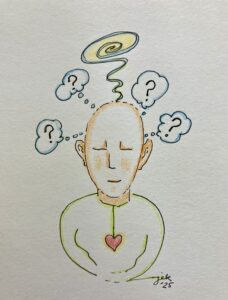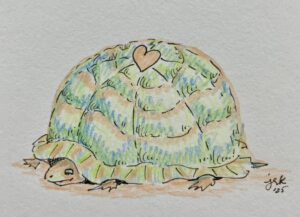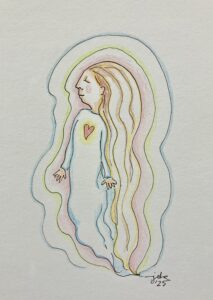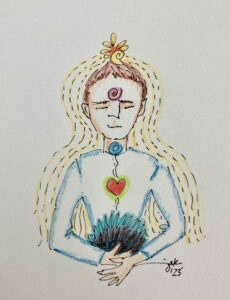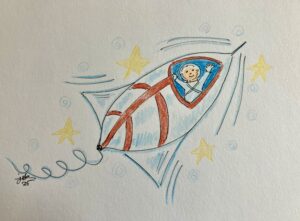
-Artwork © 2025 Jan Ketchel
We are on a quantum joyride, without seatbelts! The only choice is to let go and go with the inevitable flow. In truth, it really isn’t a choice, for we have already blasted off into the cosmos. Hold on as tightly as you will, for the ride is already fast and furious. No one can stop our present ride into the realm of quantum possibility.
Suspend judgment. Rationality cannot forestall this absolute power of absurdity. Judgment is a desperate attempt to hold onto the security of a known reality. Our known world of physical certainty is disintegrating into the fluidity of energetic possibility. With nothing to hold onto we have nothing to lose, and possibly, everything to gain.
Non-speaking autistics have been mirroring this human transformational process.* Locked into physical bodies, with limited functionality, they opened to quantum possibility. Non-speaking autistics have created a consensus reality called The Hill, where they meet and commune telepathically, defying all the laws of Newtonian physics that construct the known physical world we have lived in.
This is our destiny. All physical certainty is in jeopardy. The knowns of science and medicine, the boundaries and alliances of countries, the security of ownership, savings, and reliable currency are all losing their solidity. Like the non-speaking autistics, we are all being challenged to expand beyond physical certainty into the new possibilities latent in quantum reality.
Back to the hologram of Self. As without, so within. We all want something to change. For change to happen, the energy we have condensed to create the security of a known physical reality for ourselves must be freed in order to flow into new life. The habits our subconscious minds have solidified, to create our physical bodies and lives, must break down and be overridden for new suggestions to take shape.
Can we be as radical inwardly as the current world is outwardly? Can we let go of the security of the known, and ride instead the wave of new energetic possibility? Rather than rage at the unfairness and incredulity of the outer world, can we follow its insinuation and boldly suggest a whole new self to the subconscious mind?
Radical breakdown of the known is the suggestion being mirrored outwardly. What is also being mirrored is the exercise of divine right, albeit as both divine tragedy and divine comedy. Can we acknowledge and exercise our own true divine powers to manifest what we so desire, without falling prey to the inflation of Icarus? Are we willing to simply stop and ask the High Self, “What is truly right?”
“And what,” as many ask, “can I do about my blocking belief, which compromises the strength of my divine suggestions?”
If your suggestion is a defensive attempt to override a disowned truth, the power of that truth will likely remain the dominant suggestion to the subconscious mind. Face and integrate the truth, whereby nullifying its blocking impact and freeing desired manifestation.
And yes, even the truth can at times be overridden by suggestion, but the karma of such action is ultimately the fate of Icarus. Nonetheless, even such a fall is instructive to future development.
Perhaps the most insidious of blocking beliefs are those that doubt our divine capabilities. These may have their origin in protecting us from the fate of Icarus, yet, in so doing, they deeply bury us in deflation and limitation.
Blocking beliefs are also installed by reigning powers that seek to control us like chickens in a chicken coop. But truthfully, the worst offender is our own reluctance to change, as we secretly defeat the threat of moving beyond the security of the known, however stifling it may be.
Taking another cue from without, the tried and true way of overcoming a blocking belief is constant repetition of the same message. We have seen how effective such a strategy has been in influencing a majority of people to sign up for the reality we are currently experiencing.
Design your suggestion in consort with your High Self. Then, saturate your life with its constant repetition. This is pure rote repetition, pounding away at the door until it finally opens and takes the seed to root. Perseverance, without attachment to outcome, never fails.
Such is the truth of the pounding absurdity of now: it is inevitably taking us to the door of quantum possibility. This is the opportunity for a quantum leap, within and without.
Ready or not, the time for that leap has arrived.
In free fall,
Chuck
*Listen to The Telepathy Tapes podcast for further explanation.

